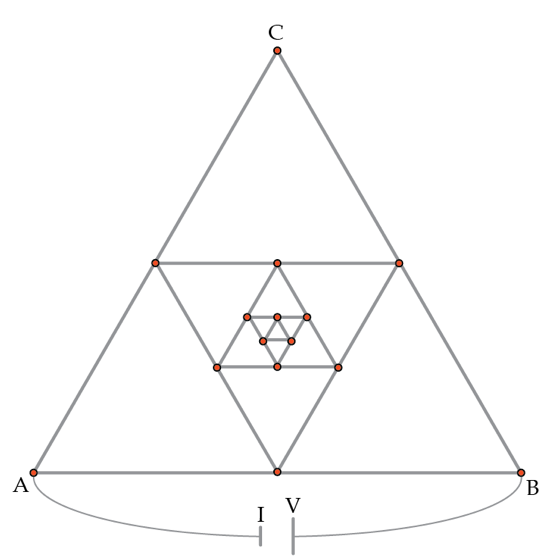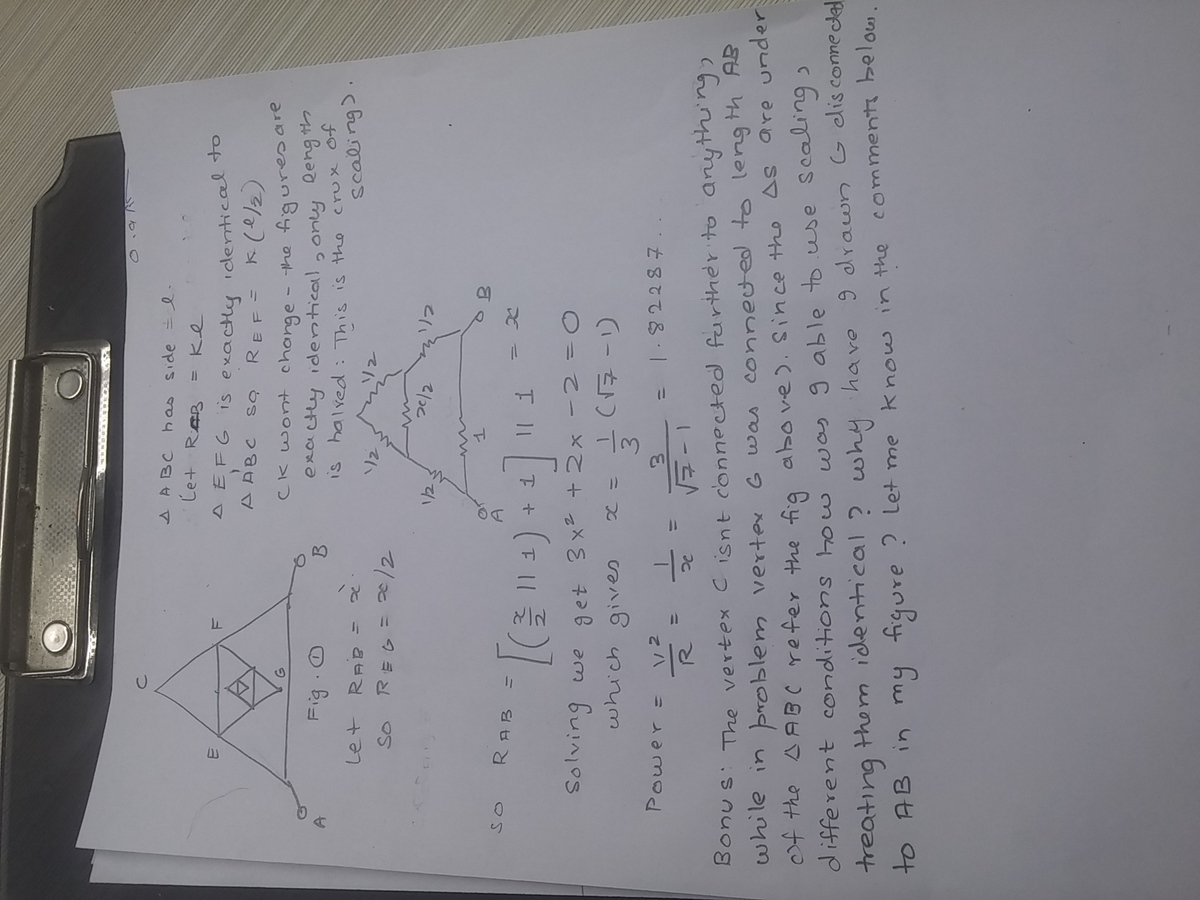Power dissipated in a fractal circuit
Suppose we take three homogeneous wires with resistance
R
=
1
Ω
and build an equilateral triangle ABC. Then we take more wires and we inscribe a smaller equilateral triangle inside the original one and we repeat this procedure many times to obtain a fractal circuit as shown in the figure below.
What will be the total power dissipated in the circuit
in Watts
if a
1
V
voltage source (or negligible internal resistance) is connected across points A and B?

The answer is 1.82.
This section requires Javascript.
You are seeing this because something didn't load right. We suggest you, (a) try
refreshing the page, (b) enabling javascript if it is disabled on your browser and,
finally, (c)
loading the
non-javascript version of this page
. We're sorry about the hassle.
2 solutions
Well, the equivalent resistance is 8 1 3 4 4 6 .
Log in to reply
Could you show your approach ? I'm getting R = 3 7 − 1 .
Log in to reply
Are you assuming infinite triangles? I am assuming 5 as only 5 are shown. If you assume infinite triangles, then resistance is 3 7 − 1 , as it satisfies 2 + 1 + 2 x 2 x 1 + 1 + 2 x 2 x = x
Infact, solving resistance for 5 triangles involves much more calculations.
Log in to reply
@Jatin Yadav – Sorry if this is really simple, but please may you explain how you got that equation jatin yadav? Thank you :)
@Jatin Yadav – can you tell me how you got that equation for finding the infinite resistance of the circuit
Even i am getting @Vijay Raghavan 's answer.
Since the middle contact can be detached as voltage difference is 0 V as can be realized by treating differently but same resultant resistance obtainable, the combination of circuit can be simplified.
r 0 = 3 1 and R 0 = 2 + 3 r 0 1 + 2 r 0
r 1 = 2 1 R 0 and R 1 = 2 + 3 r 1 1 + 2 r 1
...
1 2 3 4 5 6 7 8 9 10 11 12 13 14 15 16 17 |
|
8 1 3 4 4 6 Ω is the resistance for 5 triangles. Power = 4 4 6 8 1 3 W = (1.822869955156950672645739910313+) W.
S y m m e t r y m a k e s z e r o d i f f e r e n c e f o r t h e m i d d l e s !
Answer: 1 . 8 2 2 8 6 9 9 5 5 1 5 6 9 5 0 6 7 2 6 4 5 7 3 9 9 1 0 3 1 3 9
 I used a different approach I like to call Scaling (very useful in fractals, check out finding moment of inertia of sierpinski triangle). The trick is to realise that if the resistance across A and B is say X, then the resistance across the next inner triangle will be X/2 as for each triangle has its dimensions reduced by half compared to the immediate outer triangle and we can expect the resistance to be proportional to length. The rest is simply analysis of this circuit.
I used a different approach I like to call Scaling (very useful in fractals, check out finding moment of inertia of sierpinski triangle). The trick is to realise that if the resistance across A and B is say X, then the resistance across the next inner triangle will be X/2 as for each triangle has its dimensions reduced by half compared to the immediate outer triangle and we can expect the resistance to be proportional to length. The rest is simply analysis of this circuit.
Can you explain why G is disconnected??????
the equivalent resistance is [-1+sqrt(7)]/3 so Power= [1+sqrt(7)]/2 = 1.82 watts